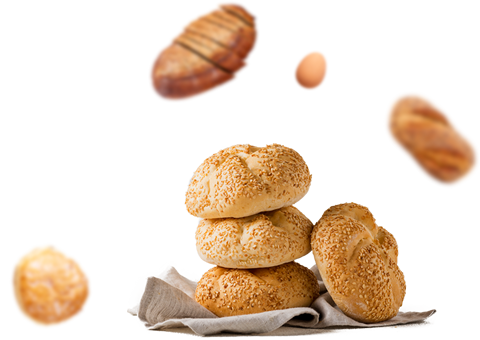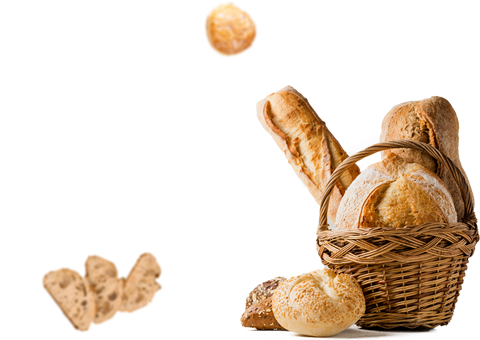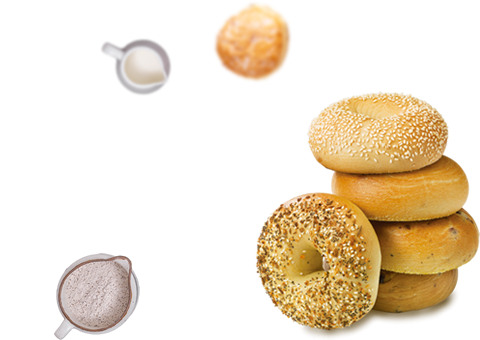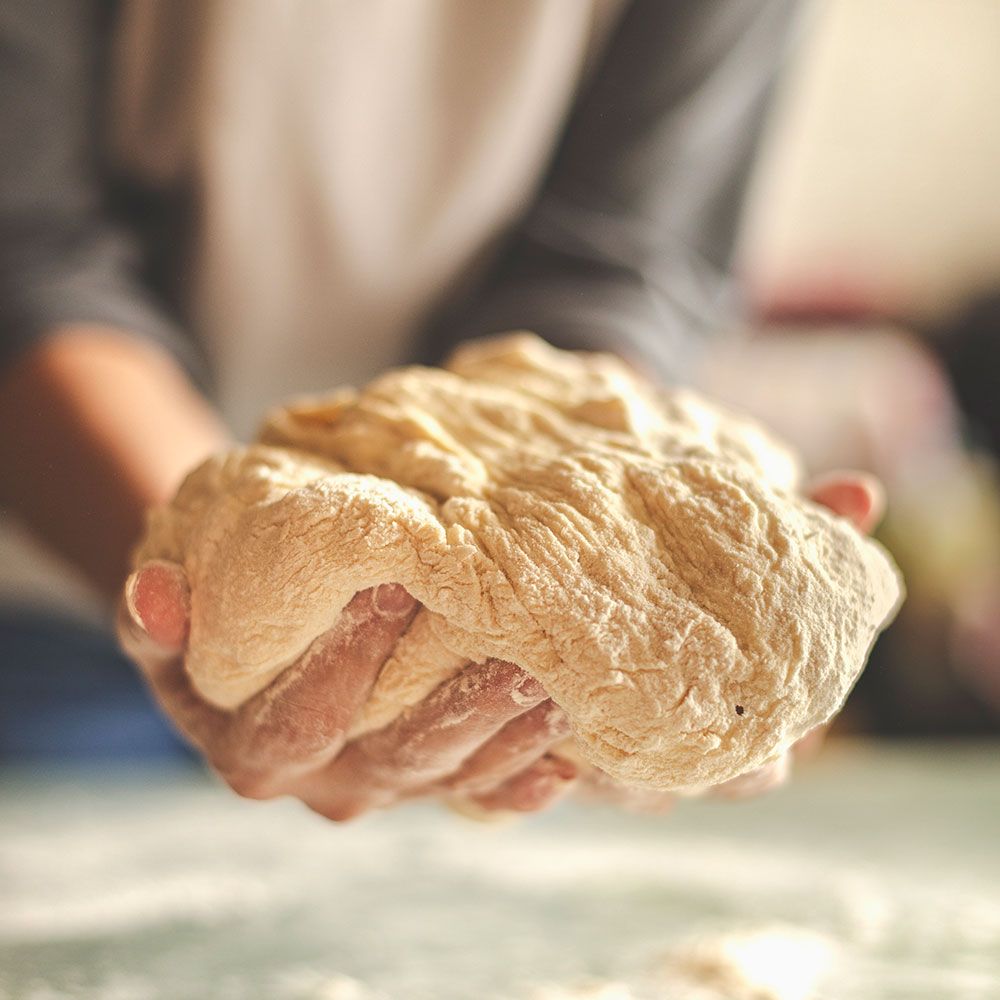6 Aralık 2021 Pazartesi
When we look at the history of bread, we see that it is as old as the history of civilizations. Bread is the oldest, most basic and important food item known to mankind.
According to the oldest accepted story, after the discovery of fire, the first people saw that pores had formed in the wheat crumb, which had been soaked with water and left to its own state, and when they cooked the porous mass on hot stones, it turned out that its taste was good.
The history of bread undoubtedly begins with the history of wild wheat and barley. Wheat is the livelihood of 35 percent of the world's population today. Kenneth F.In the book Traveler's Feast, published by Kiple's Traveler's Feast Yapı Kredi Publications, he mentions that the origin of wheat is the wild ancestors of red wheat and gemik, and says that it was first used by people in southwest Asia.
He adds that there are januaryoves, grinding stones and even food storage pits in the areas belonging to the Naturists who harvest wild grain here, that is, the foragers of the pre-Neolithic period.
When we go on a journey about 2.5 million years before our day, we reach Prehistoric/prehistoric times. The period that we call the Stone Age in the classification of these epochs dates back to 2.5 million years ago, BC.He. it lasts up to 5500 years. The Stone Age is the Paleolithic Age, called the Chipped Stone Age, which is commonly referred to as the Old Stone Age. Here is this period from 2.5 million years ago to M.He.it dates back to 12000 years ago. Mankind has led a carnivorous life while continuing its development in the conditions of the forces of nature during this long process. The nutrients it provided from wild animal hunting were its main food sources. During the periods when he was desperate about hunting, his food sources were fruits and plant roots. In the late Paleolithic period, the world's climate began to soften.
The glaciers have melted. Again, hunting was going on, and it was also diversifying with fishing. The improvement of these climatic conditions had created the environment for the formation of wild wheat and barley in some regions. There was such a temperate condition in the east of Africa, Upper Mesopotamia, Iran and Western Asia. As the weather became mild, it began to create problems for hunting animals, which are the main food, to be caught, cooked and eaten, and then the same wheel turned again. This brought with it the first steps of animal husbandry. Now at that time, animals began to be captured and kept in fenced areas. In this process, mating and fledging of animals brought about the birth of new stocks of meat. Thus, groups called shepherd communities were born.
While the process is going on, the livestock is accompanied by M.He. The Polished Stone Age, which we also call the Neolithic Age covering the years 9000-5500, covers the period when the first steps of agriculture were taken. Wild wheat M.He. before the year 9000, little red wheat and gemik (a kind of wheat) were domesticated in some way, while 48 people and bread were planted and reaped in Ceriko in the valley of the Bank and Tell Asved, which fell just southeast of Damascus. This together formed the basis for the birth of the agricultural economy. And wheat has become domesticated in a few generations. In this process, 2000 acres of fields were needed for the livelihood of a single hunter-gatherer. However, today the needs of 5,000 people from such an area can be met. Artun Unsal, in his book Blessing and October, especially in Anatolia, Diyarbakir Meadow(M.He.7000), Konya Çatalhöyük (M.He. 6800-5700), Burdur Pilgrims (M.He. 6750-6500) draws attention to the charred wheat grains uncovered during the excavations, sickles embedded in the animal's horn with flint, grinding stones, and grain storage pits.
It is also known that during the Polished Stone Age, some vegetable products such as Chestnuts and Acorns were crushed and mixed with water, and the dough obtained was eaten by cooking on hot stones or in ash.
According to the information obtained from the researches conducted in BC. in the 4000 years, the Babylonians began to bake bread in special ovens
they knew. BC again. it is understood from the findings obtained during the excavations that the art of milling and baking was practiced in 4300 years.MO. in the 2600s, the Ancient Egyptians realized that bread was softer, more fluffy when they added yeast to the dough obtained from a mixture of wheat flour and water. The Egyptian people, consisting of various classes, have known about bread for a long time. But after the yeast was found by chance, white bread became a symbol of the nobility and the palace. These yeast breads, which were in demand by the rich and noble, became so valuable that in Ancient Egypt these breads began to be used even instead of money. In the study entitled The Importance of Bread in Terms of Nutrition and Health, Prof. Dr. Aisha Baysal and Uz. Dyt. According to Nuriye Över, The dental structures of the fossils found in Egypt indicate that these people chew wholemeal, thick-shelled bread. in 1991, during the excavations of the Giza Pyramid in Egypt, M.He. ovens used by workers working in the construction of the pyramid, dated to 2575-2134, were found for making bread. In addition, bread is seen as one of the grave gifts of the Egyptians.
It is known that barley bread occupies an important place in the nutrition of the Sumerians. The Greeks, who learned the art of baking from the Egyptians and Jews, began to make bread similar to that of the Easterners. After the Romans retained the ”baked wheat" system for a long time, M.He. they learned to make bread from the Greeks in the year 600. Softer and tastier bread was obtained by adding brewer's yeast, which has been known to the Greeks and Romans since time immemorial, to traditional bread yeast. Yeast bread, which spread from Egypt to Rome and then to Western Europe, has taken its place on tables almost all over the world in the last 49 centuries of Man and Bread.
M, where commercial furnaces began to be built.He. it seems that after the year 500, some mixtures began to be used to swell bread. One of them was a mixture made from millet mixed with shiraz and could be stored for a long time. Another one was used as a yeast dough that was kneaded from white wine with wheat crumb and left for about three days. Bakers have adhered to fermentation for baking bread for many years, and the sourdough method, which is used by inoculating the dough from the previous dough, is still being applied in some regions, although it is losing its properties day by day.
M.He. in 312, there were 254 bakeries in Rome, and the product weight and price were determined by law. Along with the population concentrated here due to migration to cities, household bread has gradually been replaced by bakery bread.
In general, in the Turks, bread was usually made as unleavened bread in the hair with burning bread under it during the nomadic period before the established order, and it was called yufka or lavash. These were breads that lasted a long time. Because when 7, 8 layers of yufka were placed on top of each other and made into burritos, only the part that remained outside would dry up and the others would remain fresh.
The topic of bread in Turks is summarized as follows in Bahaeddin Ögel's book Introduction to the History of Turkish Culture, a publication of the Ministry of Culture:
“In order for a bread to be made into a burrito, even if it is thick, it must at least be in the form of a yufka. In order for such a burrito to be made, it is necessary that the bread be thin or thick pita. The types of bread that the Turks gave names such as bazlama, büskeç, sinçü, pide were among such yufka-shaped breads.”
Based on historian Cyril Mango's book Byzantium, published by Sula Bozis' History Foundation Yurt Publications, Istanbul Flavor, quotes bread in Byzantine-era Istanbul as follows:
“He states that wheat from Thrace could not meet the needs of Constantinople, and since the reign of Emperor Constantine the Great (306-337), the people of the capital have been fed on wheat from Egypt. Egypt's annual wheat production was stored in the Alexandria wheat warehouses, the “happy-fertile cargo” was brought by sea to Tenedos (Bozcaada) and unloaded into warehouses there. During periods when wheat from Egypt was in short supply, the administration had to take measures to ensure that the people did not go hungry. Since flour shortages sometimes set the stage for bloody uprisings, the emperors gave priority to meeting the “daily bread” of the people.”
Sula Bozis, in The Flavor of Istanbul, also says:
"Bread was the basic food of the Byzantine people. Various breads were produced in the capital's bakeries. 12. with 13. as mentioned in the poems of the famous dec poet Fakir Prodromos from Constantinople, who lived between the centuries, katharos artos (clean bread), made from ordinary wheat flour, was consumed by the rich for 50 People and Bread. The second-class tis ptohias (bread of the poor), which fed large masses of people, were made from a mixture of wheat, barley, rye flours. Byzantine bread bakeries were collectively located in the ”Golden Milion" area.
Wheat continued to be in state monopoly during the Ottoman period. Wheat, flour, etc. are necessary for Istanbul's daily bread needs. jul was one of the most important affairs of the state. Wheat was stored in state-owned warehouses, the sale price of which was determined by the state. He was in the Flour emini Flour Trap. The flour needed for the jul-tures, ulama, barracks and city furnaces was supplied from here.”
Eremya Çelebi Kömürciyan, 17. in his book The History of Istanbul in the XVIII century, he gives the following information:
...Ships loaded with wheat from the Crimea, Kefe, Varna, Constanta, Burgas unload their cargo at the Flour Trap berth... The pier is filled with heaps of millet, barley and wheat... up to 110 people's tortillas are baked in the oven. Friday sundowners, all of whom are Armenian, are present at 51 guilders of People and Bread early every day, except Sundays and Fridays.
The flour necessary for donuts, kata, kadayif, baklava, bagels, crisp, rusks, Aleppo and Damascus pastry, pancake, francala is taken from here ... Bread wheat is supplied from here, except for the wheat of the special bread made for jul mansions, old and new sultan palaces.
The history of bread undoubtedly begins with the history of wild wheat and barley. Wheat is the livelihood of 35 percent of the world's population today. Kenneth F.In the book Traveler's Feast, published by Kiple's Traveler's Feast Yapı Kredi Publications, he mentions that the origin of wheat is the wild ancestors of red wheat and gemik, and says that it was first used by people in southwest Asia.
He adds that there are januaryoves, grinding stones and even food storage pits in the areas belonging to the Naturists who harvest wild grain here, that is, the foragers of the pre-Neolithic period.
When we go on a journey about 2.5 million years before our day, we reach Prehistoric/prehistoric times. The period that we call the Stone Age in the classification of these epochs dates back to 2.5 million years ago, BC.He. it lasts up to 5500 years. The Stone Age is the Paleolithic Age, called the Chipped Stone Age, which is commonly referred to as the Old Stone Age. Here is this period from 2.5 million years ago to M.He.it dates back to 12000 years ago. Mankind has led a carnivorous life while continuing its development in the conditions of the forces of nature during this long process. The nutrients it provided from wild animal hunting were its main food sources. During the periods when he was desperate about hunting, his food sources were fruits and plant roots. In the late Paleolithic period, the world's climate began to soften.
The glaciers have melted. Again, hunting was going on, and it was also diversifying with fishing. The improvement of these climatic conditions had created the environment for the formation of wild wheat and barley in some regions. There was such a temperate condition in the east of Africa, Upper Mesopotamia, Iran and Western Asia. As the weather became mild, it began to create problems for hunting animals, which are the main food, to be caught, cooked and eaten, and then the same wheel turned again. This brought with it the first steps of animal husbandry. Now at that time, animals began to be captured and kept in fenced areas. In this process, mating and fledging of animals brought about the birth of new stocks of meat. Thus, groups called shepherd communities were born.
While the process is going on, the livestock is accompanied by M.He. The Polished Stone Age, which we also call the Neolithic Age covering the years 9000-5500, covers the period when the first steps of agriculture were taken. Wild wheat M.He. before the year 9000, little red wheat and gemik (a kind of wheat) were domesticated in some way, while 48 people and bread were planted and reaped in Ceriko in the valley of the Bank and Tell Asved, which fell just southeast of Damascus. This together formed the basis for the birth of the agricultural economy. And wheat has become domesticated in a few generations. In this process, 2000 acres of fields were needed for the livelihood of a single hunter-gatherer. However, today the needs of 5,000 people from such an area can be met. Artun Unsal, in his book Blessing and October, especially in Anatolia, Diyarbakir Meadow(M.He.7000), Konya Çatalhöyük (M.He. 6800-5700), Burdur Pilgrims (M.He. 6750-6500) draws attention to the charred wheat grains uncovered during the excavations, sickles embedded in the animal's horn with flint, grinding stones, and grain storage pits.
It is also known that during the Polished Stone Age, some vegetable products such as Chestnuts and Acorns were crushed and mixed with water, and the dough obtained was eaten by cooking on hot stones or in ash.
According to the information obtained from the researches conducted in BC. in the 4000 years, the Babylonians began to bake bread in special ovens
they knew. BC again. it is understood from the findings obtained during the excavations that the art of milling and baking was practiced in 4300 years.MO. in the 2600s, the Ancient Egyptians realized that bread was softer, more fluffy when they added yeast to the dough obtained from a mixture of wheat flour and water. The Egyptian people, consisting of various classes, have known about bread for a long time. But after the yeast was found by chance, white bread became a symbol of the nobility and the palace. These yeast breads, which were in demand by the rich and noble, became so valuable that in Ancient Egypt these breads began to be used even instead of money. In the study entitled The Importance of Bread in Terms of Nutrition and Health, Prof. Dr. Aisha Baysal and Uz. Dyt. According to Nuriye Över, The dental structures of the fossils found in Egypt indicate that these people chew wholemeal, thick-shelled bread. in 1991, during the excavations of the Giza Pyramid in Egypt, M.He. ovens used by workers working in the construction of the pyramid, dated to 2575-2134, were found for making bread. In addition, bread is seen as one of the grave gifts of the Egyptians.
It is known that barley bread occupies an important place in the nutrition of the Sumerians. The Greeks, who learned the art of baking from the Egyptians and Jews, began to make bread similar to that of the Easterners. After the Romans retained the ”baked wheat" system for a long time, M.He. they learned to make bread from the Greeks in the year 600. Softer and tastier bread was obtained by adding brewer's yeast, which has been known to the Greeks and Romans since time immemorial, to traditional bread yeast. Yeast bread, which spread from Egypt to Rome and then to Western Europe, has taken its place on tables almost all over the world in the last 49 centuries of Man and Bread.
M, where commercial furnaces began to be built.He. it seems that after the year 500, some mixtures began to be used to swell bread. One of them was a mixture made from millet mixed with shiraz and could be stored for a long time. Another one was used as a yeast dough that was kneaded from white wine with wheat crumb and left for about three days. Bakers have adhered to fermentation for baking bread for many years, and the sourdough method, which is used by inoculating the dough from the previous dough, is still being applied in some regions, although it is losing its properties day by day.
M.He. in 312, there were 254 bakeries in Rome, and the product weight and price were determined by law. Along with the population concentrated here due to migration to cities, household bread has gradually been replaced by bakery bread.
In general, in the Turks, bread was usually made as unleavened bread in the hair with burning bread under it during the nomadic period before the established order, and it was called yufka or lavash. These were breads that lasted a long time. Because when 7, 8 layers of yufka were placed on top of each other and made into burritos, only the part that remained outside would dry up and the others would remain fresh.
The topic of bread in Turks is summarized as follows in Bahaeddin Ögel's book Introduction to the History of Turkish Culture, a publication of the Ministry of Culture:
“In order for a bread to be made into a burrito, even if it is thick, it must at least be in the form of a yufka. In order for such a burrito to be made, it is necessary that the bread be thin or thick pita. The types of bread that the Turks gave names such as bazlama, büskeç, sinçü, pide were among such yufka-shaped breads.”
Based on historian Cyril Mango's book Byzantium, published by Sula Bozis' History Foundation Yurt Publications, Istanbul Flavor, quotes bread in Byzantine-era Istanbul as follows:
“He states that wheat from Thrace could not meet the needs of Constantinople, and since the reign of Emperor Constantine the Great (306-337), the people of the capital have been fed on wheat from Egypt. Egypt's annual wheat production was stored in the Alexandria wheat warehouses, the “happy-fertile cargo” was brought by sea to Tenedos (Bozcaada) and unloaded into warehouses there. During periods when wheat from Egypt was in short supply, the administration had to take measures to ensure that the people did not go hungry. Since flour shortages sometimes set the stage for bloody uprisings, the emperors gave priority to meeting the “daily bread” of the people.”
Sula Bozis, in The Flavor of Istanbul, also says:
"Bread was the basic food of the Byzantine people. Various breads were produced in the capital's bakeries. 12. with 13. as mentioned in the poems of the famous dec poet Fakir Prodromos from Constantinople, who lived between the centuries, katharos artos (clean bread), made from ordinary wheat flour, was consumed by the rich for 50 People and Bread. The second-class tis ptohias (bread of the poor), which fed large masses of people, were made from a mixture of wheat, barley, rye flours. Byzantine bread bakeries were collectively located in the ”Golden Milion" area.
Wheat continued to be in state monopoly during the Ottoman period. Wheat, flour, etc. are necessary for Istanbul's daily bread needs. jul was one of the most important affairs of the state. Wheat was stored in state-owned warehouses, the sale price of which was determined by the state. He was in the Flour emini Flour Trap. The flour needed for the jul-tures, ulama, barracks and city furnaces was supplied from here.”
Eremya Çelebi Kömürciyan, 17. in his book The History of Istanbul in the XVIII century, he gives the following information:
...Ships loaded with wheat from the Crimea, Kefe, Varna, Constanta, Burgas unload their cargo at the Flour Trap berth... The pier is filled with heaps of millet, barley and wheat... up to 110 people's tortillas are baked in the oven. Friday sundowners, all of whom are Armenian, are present at 51 guilders of People and Bread early every day, except Sundays and Fridays.
The flour necessary for donuts, kata, kadayif, baklava, bagels, crisp, rusks, Aleppo and Damascus pastry, pancake, francala is taken from here ... Bread wheat is supplied from here, except for the wheat of the special bread made for jul mansions, old and new sultan palaces.
 Production FacilityAccordingly, we operate with a daily capacity of 1600 tons in 3 factories as of 2019.
Production FacilityAccordingly, we operate with a daily capacity of 1600 tons in 3 factories as of 2019.
 Quality CertificatesWith its 45 years of experience, permits, awards and certificates, Osmanlı Un is always with you!
Quality CertificatesWith its 45 years of experience, permits, awards and certificates, Osmanlı Un is always with you!
 Representatives24 countries on 3 continents from the Middle East to the Arabian Peninsula and from Africa to Asia
Representatives24 countries on 3 continents from the Middle East to the Arabian Peninsula and from Africa to Asia
Our company which exports to 24 countries on 3 continents from the Middle East to the Arabian Peninsula and from Africa to Asia, increases its share in the global market every year.


